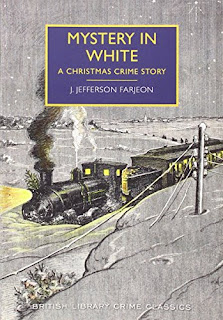A ‘creepy’ Christmas story with all the classic festive ingredients
 |
| John Jefferson Farjeon was a journalist who went on to be a successful novelist |
No one answers the bell at the first house they find, but
when they try the door handle it turns and they stumble inside with relief. The
fires are lit, the table is set for tea, but surprisingly there is nobody at
home.
It is obvious the occupants would not have ventured out in
such extreme weather conditions unless there had been an emergency and the
house has clearly been prepared for guests, so despite uncomfortable feelings
of guilt, the train travellers warm themselves by the fire, eat the tea that
has been prepared and set out to solve the mystery.
The main sleuthing brain belongs to an elderly gentleman, Mr
Edward Maltby, of the Royal Psychical Society, who uses a mixture of reasoned
logic and psychic intuition to try to work out what has happened to the
occupants of the house.
He is ably assisted by a bright young man, David Carrington
and his cheerful sister, Lydia, who has practical skills. A chorus girl, Jessie,
who has fallen in the snow and sprained her ankle, a young clerk called Thomson
who succumbs to ‘flu, Hopkins, an elderly bore, and Smith, a rough man who
turns out to be a criminal, complete the Christmas house party.
 |
| Mystery in White is published as a British Library Crime Classic |
He was a major figure during the Golden Age of murder
mysteries between the two world wars and Dorothy L Sayers praised him for being
‘quite unsurpassed for creepy skill in mysterious adventures.’
Farjeon was named after his maternal grandfather, Joseph
Jefferson, who was an American actor. His father, Benjamin Farjeon, was a
successful novelist, one of his brothers was a composer, another a drama critic
and director, and his sister, Eleanor Farjeon, wrote poems, including the words
for the hymn, Morning Has Broken.
Originally published in 1937, Mystery in White was
republished as a British Library Crime Classic in 2014. Like most Golden Age
mysteries, it has a satisfying, logical conclusion, brought about by the deductive
powers of Mr Maltby and the heroics of David.
At the end of the story, the police inspector, who manages to
reach the house on Christmas Day, remarks to his sergeant: “Four murders in a
dozen hours! I reckon I’ve earned my bit of turkey.”
When the owners of the house return they are happy to forgive the intrusion by the party from the train. As Lydia had said earlier to the chorus girl, Jessie: “Suppose this house belonged to you and you returned to it after the world’s worst snowstorm, would you rather find your larder empty or seven skeletons?"


.jpg)
